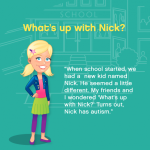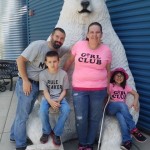
Teen Wins Award For A Coding Program
In 2020, Sreenidi Bala, a teenager from Farmington, Connecticut, started a passion project that would change the lives of hundreds of autistic students.
Two years ago, I decided it was time to talk to my son’s classmates about autism. Matthew was at a school that included kindergarten through third grade. My goal was likely the same as yours or any parent of a child with autism: I wanted my child to be understood and liked by his classmates.
The suggestions I have for you are based on my experience presenting the Kit for Kids over the past two years.
After I made the decision to talk to the students at Matthew’s school, I did my homework before I met with the principal: I knew the school had recently done a program for students about epilepsy. And I knew how many kids with autism went to the school and had an estimate for how many more might be undiagnosed.
What I didn’t do was look for a program first. If I had it to do over again, I would have found a program first and then approached school leadership. When I found OAR’s Kit for Kids online, I was thrilled! It had everything I needed, from visuals to interactive activities to suggestions for how to present it in schools.
Find other parents to help. Reaching out to the PTA or PTO is probably your best bet. I asked for volunteers through the school’s Facebook page. While I only got one response, that mom helped me both years. If you do have more than one volunteer, create an online sign up so that all the volunteers and school staff can see who has signed up.
 When I got two of the Kits, I took them to the school with a printed explanation of how the lesson plans worked. That explanation also included the link to the “What’s Up With Nick?” video. As the teachers looked over the printed material, I pulled up the video on the computer. Because of how busy teachers and administrators are, it’s a good idea to give them time to respond. I tried to give the principal a week to think about anything I suggested to her.
When I got two of the Kits, I took them to the school with a printed explanation of how the lesson plans worked. That explanation also included the link to the “What’s Up With Nick?” video. As the teachers looked over the printed material, I pulled up the video on the computer. Because of how busy teachers and administrators are, it’s a good idea to give them time to respond. I tried to give the principal a week to think about anything I suggested to her.
To make sure the teachers felt invested in what we were doing, I asked for their feedback on how to make the Kit work for the students in their classrooms. In fact, some teachers wanted to do the presentations themselves and I was all for that. The other parent volunteer and I came in to support those teachers as needed.
We gave surveys to the teachers so they could let us know what worked and what didn’t after the presentations. We also gave pre- and post-tests to the kids so we could see if their knowledge about autism had improved.
We included the teachers in brainstorming presentation ideas, and we came up with some creative ways to present the Kit. These are some of the things we did:
The kids loved it. I was particularly moved by how responsive the kids in Matthew’s class were. Their eagerness to participate was a sign of how much they love Matthew, and that alone made the work I put into presenting the program worth it. I hope you have the same rewarding experience.
 Pearl Fessenden is the mother of two children: Matthew, who has autism spectrum disorder, and Carmen, who has Asperger syndrome. Her strongest ally besides her husband is coffee. She is a parent mentor and is currently working on getting other school districts to use the Kit for Kids program for the upcoming school year. The Fessenden family lives in Rhinelander, Wisc
Pearl Fessenden is the mother of two children: Matthew, who has autism spectrum disorder, and Carmen, who has Asperger syndrome. Her strongest ally besides her husband is coffee. She is a parent mentor and is currently working on getting other school districts to use the Kit for Kids program for the upcoming school year. The Fessenden family lives in Rhinelander, Wisc